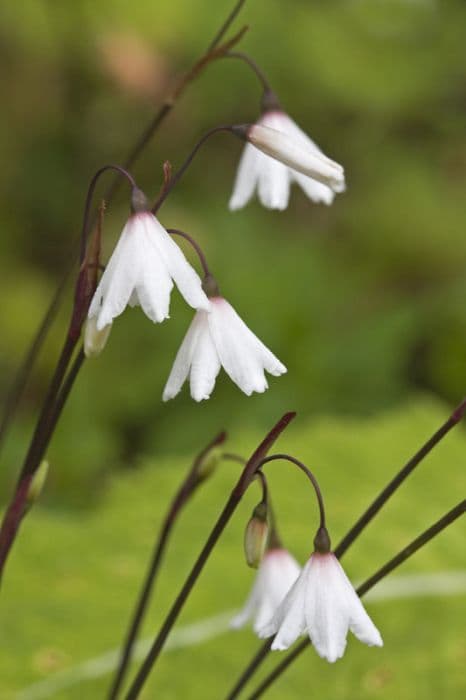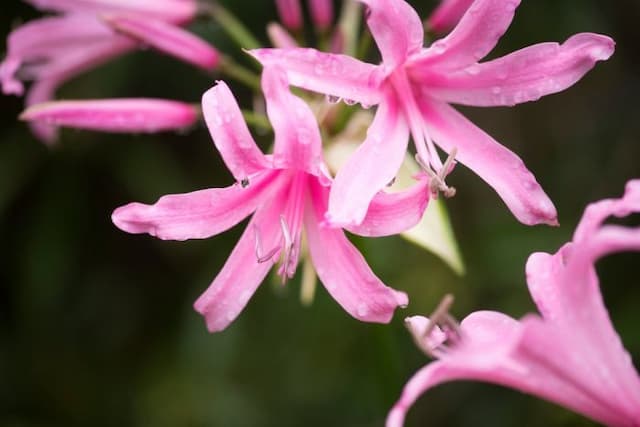Daffodil Narcissus 'Gillan' (11a)

ABOUT
Narcissus 'Gillan' is a captivating variety of daffodil characterized by its striking flowers. Each bloom of this plant is comprised of a central cup or corona that is surrounded by six petal-like segments, known as the perianth. The petals are typically a soft, creamy white while the cup stands out in a contrasting shade. The corona may showcase a vivid color, often presenting in a different hue, such as orange or yellow, adding an eye-catching appeal to the overall look of the flower. The plant bears its blooms atop sturdy, upright stems that emerge from a base of long, slender leaves. The foliage is a rich green color, forming an elegant backdrop that accentuates the beauty of the flowers. The leaves are typically sword-shaped, with a slight arch, adding to the graceful silhouette of the plant. Narcissus 'Gillan' blooms during the spring, offering a delightful display of color and form. The flowers are known for their symmetrical shape and their ability to bring a sense of brightness and cheer to the garden landscape. This particular daffodil variety is often appreciated for its ornamental value and is a favorite for cut flower arrangements as well. The overall appearance of Narcissus 'Gillan' embodies the classic charm and elegance associated with daffodils, making it a prized selection for gardeners and flower enthusiasts alike.
About this plant
 Names
NamesFamily
Amaryllidaceae.
Synonyms
Daffodil, Jonquil, Narcissus.
Common names
Narcissus 'Gillan'
 Characteristics
CharacteristicsLife cycle
Perennials
Foliage type
Deciduous
Color of leaves
Green
Flower color
White
Height
1-1.5 feet (30-45 cm)
Spread
0.5 feet (15 cm)
Plant type
Bulb
Hardiness zones
3-9
Native area
Europe
Benefits
 General Benefits
General Benefits- Aesthetic Appeal: Daffodils, including Narcissus 'Gillan', add vibrant color and beauty to gardens and landscapes in early spring.
- Low Maintenance: They are relatively easy to grow and require minimal care once established.
- Drought Tolerance: Once established, daffodils can tolerate periods of dry weather, making them suitable for various climates.
- Pest Resistance: Daffodils are generally resistant to pests, reducing the need for chemical treatments.
- Deer and Rodent Resistance: The bulbs are toxic to deer and rodents, which tend to avoid them, protecting other nearby plants.
- Naturalizing: Over time, daffodils can spread and naturalize, creating larger displays year after year.
- Longevity: Daffodils are perennial and can return for several years with proper care, providing long-term garden interest.
- Cut Flower Potential: They can be cut and used in floral arrangements, bringing spring beauty inside the home.
- Symbolic Meaning: Daffodils are associated with rebirth and new beginnings, often symbolizing the coming of spring.
- Garden Design: They work well in borders, under trees, and in containers, offering versatility in garden design.
 Medical Properties
Medical PropertiesThis plant is not used for medical purposes.
 Air-purifying Qualities
Air-purifying QualitiesThis plant is not specifically known for air purifying qualities.
 Other Uses
Other Uses- Narcissus 'Gailan' can be used in fabric dyeing, as the bulbs contain compounds that produce a yellow-green color.
- The slimy substance from crushed narcissus bulbs can be applied to the hands to provide grip for climbers or athletes.
- Aquatic arrangements can utilize narcissus flowers by floating the blooms as a decorative element in water features.
- Dried narcissus petals can be incorporated into homemade potpourri blends to add a unique fragrance and texture.
- Narcissus flowers can be used as a natural pest repellent when planted in and around vegetable gardens, as some pests are deterred by their scent.
- The strong-scented narcissus flowers can be used in making natural perfumes or scented sachets for closets and drawers.
- Use the sturdy, hollow stalks of the narcissus plant to create miniature handcrafted flutes or musical whistles for children.
- Narcissus bulbs can be used in a classroom setting to teach children about plant biology and growth cycles in a hands-on manner.
- Narcissus flowers can be incorporated into art projects, such as pressing the flowers for inclusion in greeting cards or collages.
- During special occasions, floating narcissus blooms can serve as organic confetti alternatives that are biodegradable and add a touch of nature to events.
Interesting Facts
 Feng Shui
Feng ShuiThe Daffodil is not used in Feng Shui practice.
 Zodiac Sign Compitability
Zodiac Sign CompitabilityThe Daffodil is not used in astrology practice.
 Plant Symbolism
Plant Symbolism- Self-Love: Named after the mythological figure Narcissus who fell in love with his own reflection, Narcissus 'Gillan' symbolizes self-appreciation and love.
- Vanity: In reference to the narcissistic nature of its namesake, this plant can represent narcissism and excessive self-focus.
- Renewal: As a plant that blooms in spring, Narcissus 'Gillan' is often seen as a symbol of new beginnings and the rejuvenation of nature.
- Wealth: With its bright and appealing flowers, Narcissus 'Gillan' is sometimes seen as a symbol of prosperity and good fortune.
- Hope: Spring flowering plants like Narcissus 'Gillan' herald the end of winter, making them emblems of hope and the anticipation of warmer days to come.
 Water
WaterFor the Daffodil 'Gillian', it is best to water deeply and allow the soil to dry out slightly between waterings to prevent over-watering and potential bulb rot. Typically, watering once a week with about 1 inch of water should be sufficient, depending on the climate and soil type. During the growing season in spring, make sure to provide consistent moisture. However, once the foliage begins to die back after flowering, reduce watering. No water is necessary during the summer dormancy period when the bulbs are underground.
 Light
LightDaffodil 'Gillian' thrives in full sunlight to partial shade. The ideal spot is where the plant can receive at least six hours of direct sunlight each day. However, in hot climates, dappled shade during the peak afternoon sun can help protect the blooms from excessive heat.
 Temperature
TemperatureDaffodil 'Gillian' prefers cool to moderate temperature conditions, ideally ranging between 50°F and 70°F. They can tolerate minimum temperatures down to about 20°F and maximum temperatures up to 75°F comfortably. The bulb should be planted in autumn to ensure a cold dormancy period which is crucial for spring blooming.
 Pruning
PruningPruning Daffodil 'Gillian' generally involves deadheading spent blooms to encourage the plant to redirect energy into bulb growth. Do not cut back the foliage until it has yellowed and withered, usually six weeks after flowering, as this period allows the plant to store energy for the next season. Pruning is low-maintenance and typically done once the blooming period is over.
 Cleaning
CleaningAs needed
 Soil
SoilDaffodil 'Gillian' prefers well-draining soil with a mix of loam, sand, and compost, with a pH between 6 and 7.
 Repotting
RepottingDaffodil 'Gillian' should be repotted every 2-3 years to refresh soil and separate overcrowded bulbs.
 Humidity & Misting
Humidity & MistingDaffodil 'Gillian' tolerates average humidity levels found in most homes without the need for adjustment.
 Suitable locations
Suitable locationsIndoor
Place in bright, indirect light and keep soil moderately moist.
Outdoor
Plant in partial shade to full sun, well-drained soil.
Hardiness zone
4-8 USDA.
 Life cycle
Life cycleNarcissus 'Gillan', commonly known as Daffodil 'Gillan', begins its life cycle when a bulb is planted in the ground, typically in the fall before the first frost. During the winter, the bulb undergoes a period of cold dormancy which is necessary for spring growth. With the onset of warmer temperatures and spring rains, the bulb sprouts and produces long, narrow leaves, followed by a central stalk that bears the characteristic flowers, typically in late winter to early spring. After flowering, the plant directs energy back into the bulb as the leaves photosynthesize to replenish its energy reserves. Once the foliage dies back naturally, the plant goes into a dormant state throughout the summer months. The bulb can remain in the ground, where it will begin the cycle anew the following spring, or it can be divided and replanted to propagate new plants.
 Propogation
PropogationPropogation time
Spring-Early Summer
Propogation: The most popular method of propagating Narcissus 'Gillan', commonly known as Daffodil 'Gillan', is by dividing and transplanting the bulbs. This is typically done in the late summer to early fall, after the foliage has died back but before the ground freezes. To propagate, carefully dig around the daffodil clumps and gently lift them out of the ground with a garden fork. The bulbs can then be separated by hand, as offsets will readily detach from the parent bulb. It is important to ensure that each division has at least one growing point or 'nose.' After dividing, the bulbs should be replanted at a depth of about 6 inches (about 15 cm) and spaced approximately 6 inches (15 cm) apart to allow for ample growing room. This method is simple and effective, often leading to a healthy bloom in the following spring.









